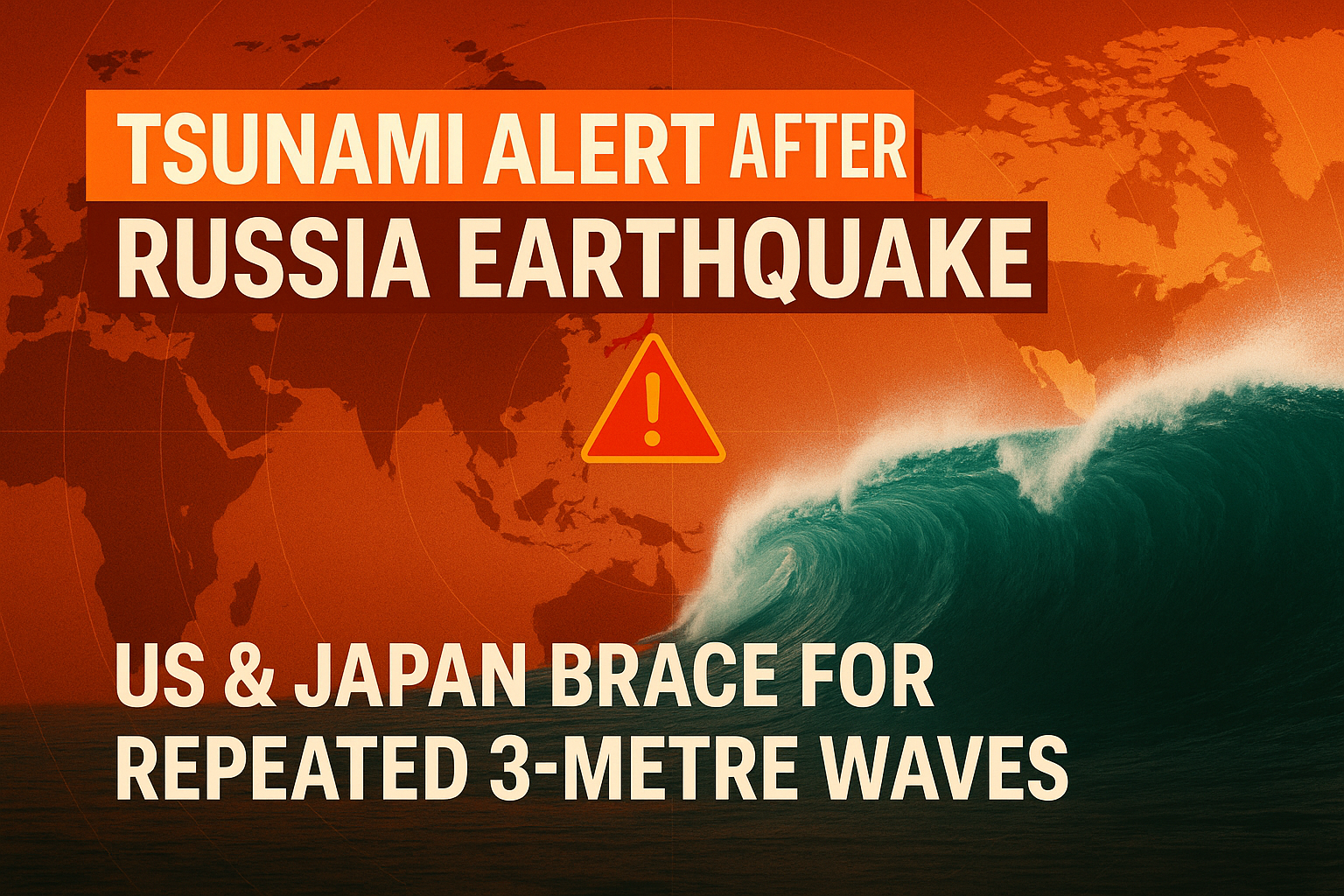A powerful earthquake that struck off the eastern coast of Russia has triggered widespread tsunami warnings across the Pacific region, especially in Japan and the United States’ West Coast. Authorities have warned that tsunamis could strike repeatedly, with waves as high as 3 metres (10 feet), raising concerns of potential coastal damage and public safety.
What Happened?
The earthquake, which measured 7.5 to 8.2 magnitude, hit near the Kuril Islands — a seismically active region between Russia and Japan. The quake occurred at a shallow depth beneath the ocean floor, which significantly increased the risk of tsunami generation.
Russia is getting clobbard by the TSUNAM. They had very little warning where it was where the Epicenter was of the 8.7 just 40 miles off the coast. pic.twitter.com/RoJkhfJvyA
— L.A 🇺🇲♥️ (@FACTMATTER2024) July 30, 2025
Tsunami Alerts Issued:
- Japan: The Japan Meteorological Agency has issued tsunami warnings for coastal prefectures in Hokkaido and northern Honshu. Evacuation advisories were broadcast in multiple cities.
- United States: The US National Tsunami Warning Center (NTWC) issued an advisory for parts of Alaska, Hawaii, and the US West Coast, including California, Oregon, and Washington. Coastal residents have been advised to stay away from beaches and harbors.
- Russia: Authorities in the Far East regions, including Sakhalin and Kamchatka, have also issued evacuation orders in low-lying coastal towns.
Officials Warn of Multiple Waves
Emergency management agencies across the Pacific are emphasizing that the first wave may not be the largest, and that successive waves could continue for hours. Residents are urged to stay away from the coast until the all-clear is given.
“Do not return to low-lying areas until officials declare it safe,” said a spokesperson for Japan’s disaster response agency.
#BREAKING
— MəanL¡LMə♡₩ (@MeanLILMeoW) July 30, 2025
Yuzhno-Sakhalinsk, Russia
8.7 Earthquake – 46 Miles deep in the Ocean
ALL OF THE WEST COAST IS UNDER TSUNAMI WARNING –
We will know soon if the bouys pick up the TSUNAMI level soon here
Millions of people could end up evacuating depending how this goes.
Hard to… pic.twitter.com/w54KXkE3If
Flight & Shipping Disruptions
- Several airports in coastal Japan have halted operations temporarily.
- Ports in Seattle, Vladivostok, and Tokyo are closely monitoring the situation.
- Maritime traffic has been warned to avoid vulnerable areas.
Safety Measures and Emergency Steps
Authorities recommend the following precautions:
- Move to higher ground immediately if you’re in a tsunami warning zone.
- Avoid bridges, shorelines, rivers, and bays.
- Keep emergency kits, food, water, and radios ready.
- Stay tuned to official alerts via government apps and weather stations.
Why Is This Earthquake So Dangerous?
The Kuril-Kamchatka Trench is one of the most active seismic zones on Earth. Major undersea quakes here often trigger tsunamis that impact nearby coastlines within hours. Experts are closely watching for aftershocks or further seismic activity.
🚨 JUST NOW: Tsunami waves ALREADY slamming into Russia after the earth quake. Hawaii is under a warning right now.
— Eric Daugherty (@EricLDaugh) July 30, 2025
Buildings can be seen washing away.pic.twitter.com/ZmqpJNbscb
Live Updates & Further Warnings
Government agencies in Russia, Japan, and the U.S. have activated their disaster response teams and are monitoring wave patterns via satellite. Tsunami sirens and emergency broadcasts continue across the affected regions.
Conclusion
This is a developing situation. With tsunami waves feared to reach up to 3 metres and repeat in intervals, coastal populations are strongly advised to stay alert, follow evacuation orders, and stay away from the water.
Disclaimer :
Disclaimer: The information provided in this article is based on preliminary reports from official agencies including the Japan Meteorological Agency and the US Tsunami Warning Center. The situation is developing, and readers are advised to follow local government alerts and news updates for real-time instructions and safety measures. This article is intended for informational purposes only and should not be considered as an official emergency guide.

